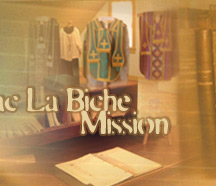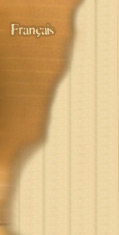






Education/Schools/Students | Nuns | Oblates
Domestic Services
| Sisters of Charity | Filles
de Jesus | Letters | Letters 2
| Life at Lac La Biche | Propagation
| Propagation 2
NUNS
Letters
1St July, 1898
To: North-West Territories LLB Boarding School, LLB
From: H. Grandin, Ptre. Principal
Buildings: Large enough with the exception of
classrooms and dormitories.
Heating: The school is heated by wood stoves.
Recreation: Outdoor exercise and in house games.
I arrived at the convent and was welcomed by the nun who does the cooking, the others were cleaning the rectory – I supervised the children who remained there during the holidays, at night I slept in the dorm with the children.
Description – As we enter, I could see stairs, walls, and on the left of the building, "une sane".
Dining room – The door of the dining room looked like a barn door with a large "Z" on it.
Stove – The stove could only be fed with large wood and was huge!
Floor – The floor had large knots and wide boards. To sweep we had to put sawdust on the floor in order to control the dust.
Laundry – The wash was done a few times a year.
Windows – They have no screens. There was so many insects, we could have made lots of pies! I demanded screens and finally they were installed by Frere Cote.
Walls – 3' high around the room, color: "boiserie"(dictionary def.- panelling, wainscoting (the lower part of an interior wall when finished in a material different from the upper part), "en jute" ( In English, "jute" is fiber used
to make rope, twine and burlap).
Color – Dark green (I don't remember the rest of the detailed colors here and there)
Main Floor
-On the left of the stairs, in front, there was a refectory for the priests, (a room where meals are served).
-A large wood stove was used to heat two rooms, the room
for the refectory and the children's dining room (separated by a wall made
with boards with a door).
-Three large tables, 26 children, 13 boys and 13 girls.
Very Crowded!
-Weather: Children inside, 65 degrees below zero! Stoves:
Kitchen: Heated with coal all night, which also heated the chapel. The exterior
walls were not very thick!
-Nuns Dining Room: Located behind the kitchen "Celle-ci
sous la chapelle" (Underneath the chapel) We ate behind the stove, our
hands were cold!
-Kitchen: Three barrrels of water, with a "boyau"
(a pipe or hose) through the window, "which would dirty all the kitchen."
-Next to the Kitchen: "Les depenses", floor
traps and stairs lead to every access.
Second Floor
- Chapel.
- Mother Superior's Bedroom.
- Small room for three Nuns and 7 children, because there was not enough room upstairs.
- Two classrooms, for 60 students.
- Stairs were on the side of the room to climb up to the dormitory.
Third Storey
- Dorm: Beds for boys on one side, girls on the other side. Divided by a wall.
- Saturday night we would haul hot water in pails from the kitchen to give the children baths. We would give basins to the older ones and small tubs for the little ones.
- There was no "social" living room, therefore we would meet in the refectory (dining room). Eventually, the room that had "matelas" mattresses became the living room.
Fire in the convent
- In Chapel: The statue of the Virgin Mary was on the floor, the curtains all burnt and the fire was out.
- In the refectory: "Un bocal de chaux" (jar of lime?) on fire.
- The fire was inbetween the two floors.
- With pails of water it was put out.
Improvements
- Chapel: Baseboards, doors, frames on windows, "d'orure neuve" (glaze), using combs for special effects to
decorate.
- Varnished all the benches.
- Convent, for boarders, condemned by the government.
- "In the afternoon we went to the convent to make the boarders bath. We were able to use the showers in the dorm for the girls. In the morning I was busy upstairs in the new dorm.
- We started presenting concerts in the convent in the theater in the “salle” (dining room?). The benches from the church
were used.
Written in 1990 by S. Rita Kemp El. at 80 years old.
Written in French. (S. Alcantara-M) (1939-1953)
© 2003 Société
culturelle Mamowapik and the Lac La Biche Mission Historical
Society (All Rights Reserved)
 |
 |
|
|
|
|
||||||||||||
|
|
|
|
|
 |
|
||||||||||||
 |
|
||||||||||||||||
 |
|
||||||||||||||||
| |
|
|
|
|
|
|
|
|
|
|
|||||||
 |
 |
|
|||||||||||||||
|
|
|
|
|
|
|
|
|
|
|
|
|
|
|
|
|
|
|